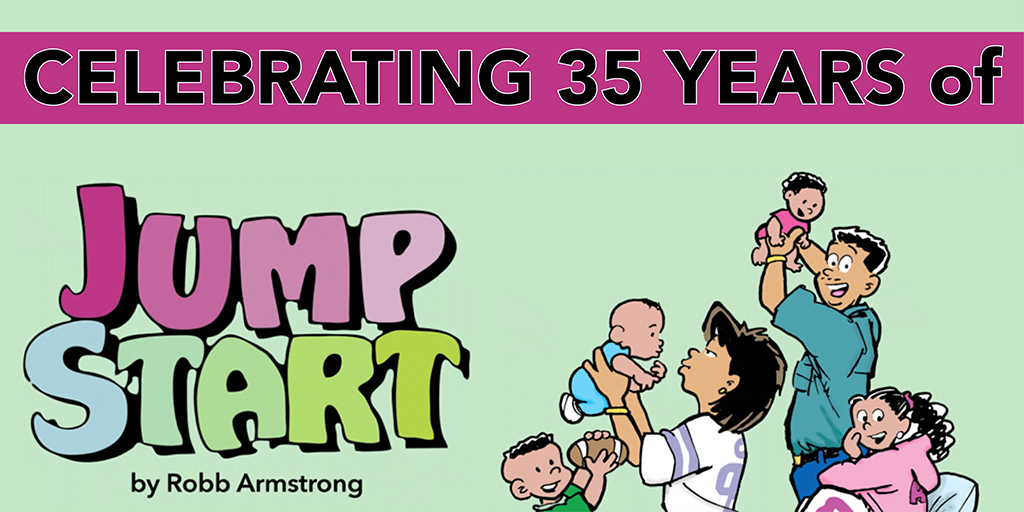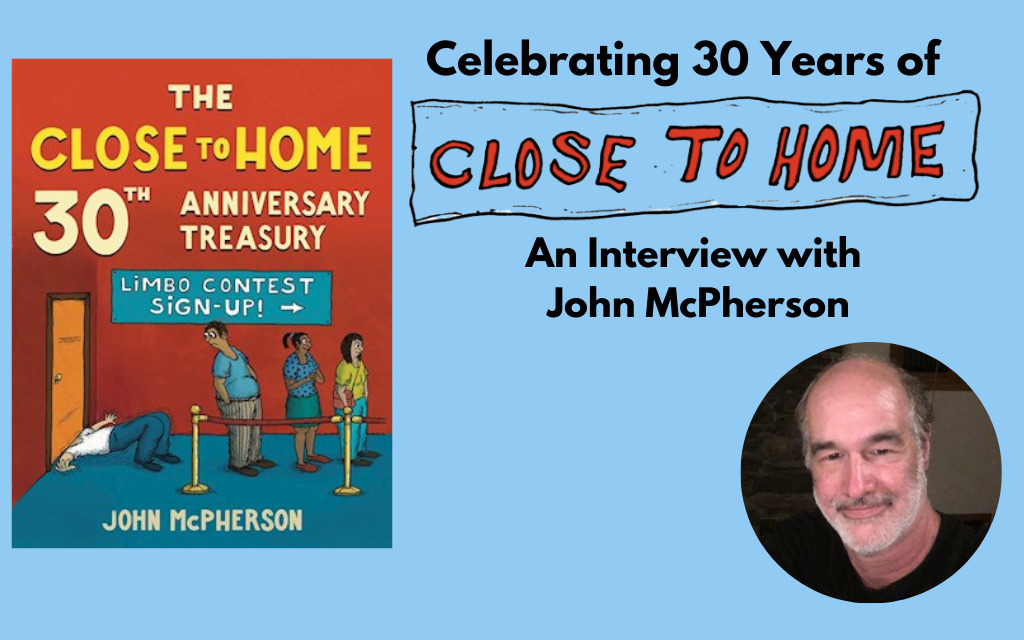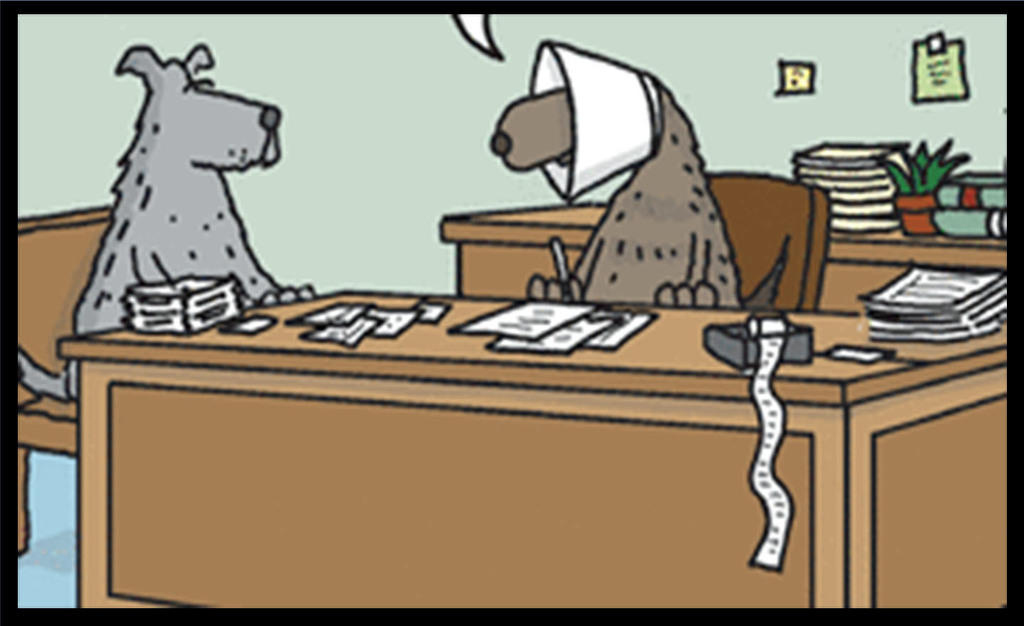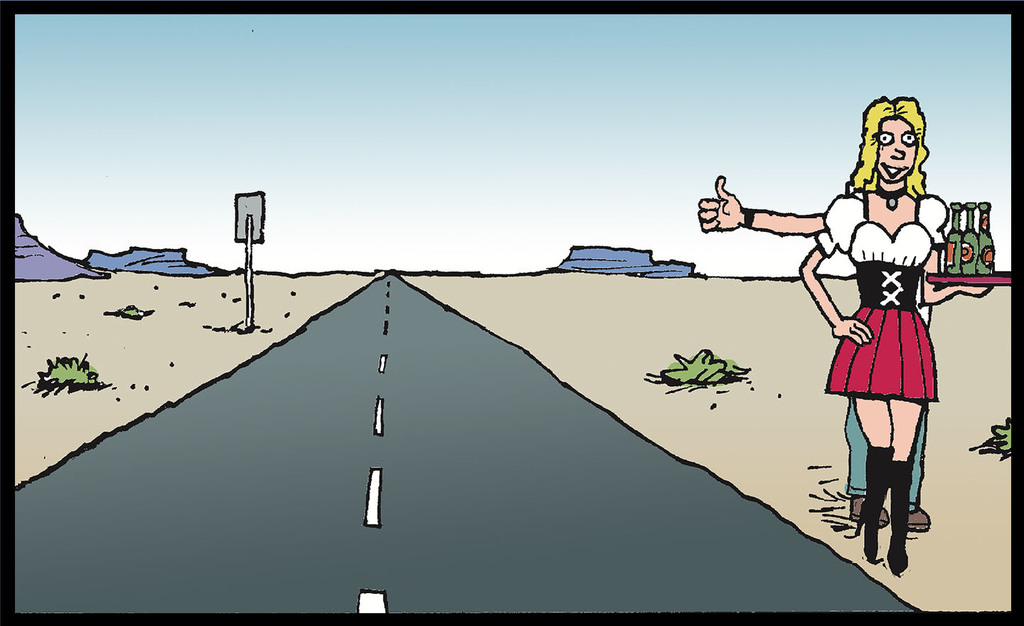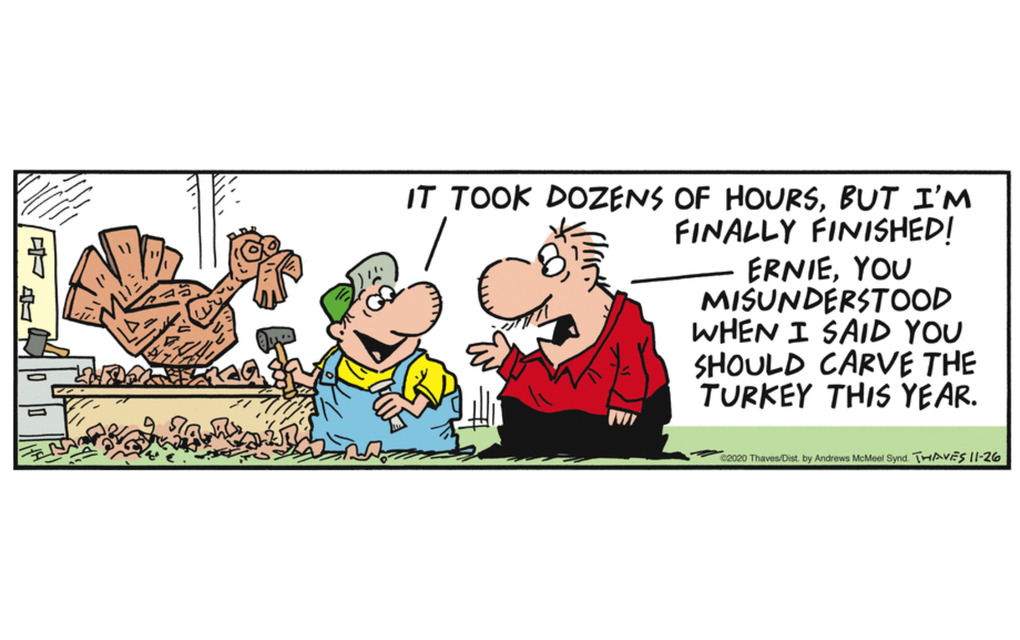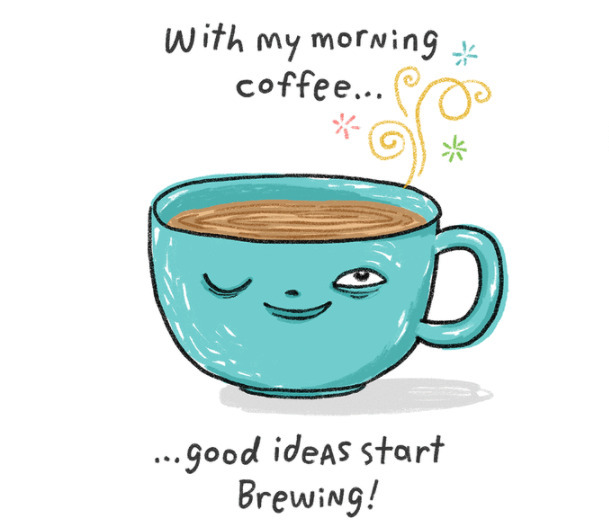Steve McGarry (Badlands, Biographic, KidTown, Trivquiz)
by GoComicsHow did you begin your career as a cartoonist? When did you start cartooning?
I was raised in Manchester, England, in a fairly tough working-class area called Wythenshawe, where people traditionally got their hands dirty, not their fingers inky. However, I was always a pretty creative kid, obsessed with soccer, pop music and drawing. If I wasn't playing "football" or strangling Beatles songs as I tried to master guitar, I was sprawled out on the living room carpet in front of the gas fire, drawing my favorite footballers and pop stars or copying my favorite cartoon characters.
Most families in Britain were two-newspaper households, reading a national newspaper each morning and a regional at night. Each national ran four or five comic strips on an exclusive basis "... so if you wanted to read Garfield, you'd take The Daily Express, Peanuts was in The Daily Mail and Hagar was in The Sun. We were a Daily Mirror household, so as a kid I was a big fan of Reggie Smythe's Andy Capp and another strip called The Perishers, which, in hindsight, was a British version of Schulz's Peanuts. When I moved to the United States many years later, it slowly dawned on me that I am one of the few cartoonists in America who doesn't cite Sparky as an influence - mainly because I never actually saw the strip when I was growing up! I think that you can probably still detect the Smythe influence in my Badlands comic strip if you look closely enough.
I also adored the work of Frank Bellamy, who illustrated the Mirror's Garth strip in a wonderfully detailed and realistic style. He frequently employed a stipple technique, as did Charles Dupont on his stunning sports illustrations. Paul Trevillion was Britain's most famous sports illustrator at that time and The Mirror also used him extensively. The stipple technique I use on features like Biographic and Trivquiz is undoubtedly a direct result of studying their work during my early teens.
Finding that both cartooning and illustration came easily to me, I happily alternated between the two styles "... and this ability to work in both disciplines has since served me well in my career, allowing me to switch from the detailed photorealistic style I employ on features such as Biographic, to the looser, more humorous approach I take on the likes of Badlands and KidTown.
From an early age, I suppose I must have always harbored thoughts of somehow drawing for a living, but had no idea how to go about it. When I left school, I toyed with the idea of art school, but somehow ended up in the production department of a large mail-order company, where I quickly became adept at the skills of graphic art and design, mastering layout techniques, learning to apply Letraset type and mechanical tints and inhaling Cow Gum fumes as I pasted up type. (In those pre-Mac days, type was set by an outside house and supplied on sheets that were physically applied to the artwork. It was all very primitive!)
During quiet spells, I'd raid the studio's materials to work on my comics and illustration portfolio. Romeo, a weekly comic aimed at preteen girls and published by Scotland's D.C. Thomson, featured pop star illustrations, so I plucked up the courage to send in samples of my drawings. To my delight and utter astonishment, they immediately commissioned me to illustrate the romantic center-spread story. My illustrations for Beardie and the Blonde were published in March 1974. I was 21 years old. Over the next couple of years, I picked up the occasional commission from the company, all the while gradually honing my technique.
Around this period, I was messing around in various rock bands, singing and playing some guitar. Consequently, I knew lots of musicians, and when the punk-rock revolution erupted in 1976 and independent record labels began springing up all over the place, I was the illustrator and designer that everyone without a budget turned to for a favor! A fanzine design here, record-sleeve artwork there, in return for a nominal fee, free beer and a backstage pass. By the following year, the world of mail order catalogues was looking pretty dull by comparison ... and my debauched lifestyle was playing havoc with that 9 a.m. start. In a fit of giddy optimism and unbridled hubris, I handed in my resignation in the summer of 1977. I was 24 and I've been freelance ever since!
The next few years were scant on cash, but loaded with fun. I made a meager living doing posters for a local rock venue and designing album sleeves. (By now, a number of those fledgling bands I'd worked with had signed deals with major labels, and I was rewarded for my earlier support by being commissioned to design their sleeves in return for handsome fees.)
I eventually rented studio space in an ad agency and was soon doing a lot of "below the line" illustration and design, mainly for black and white newspaper ads. In 1981, purely on a whim, I sent samples of my illustration work in to a couple of national newspapers. Almost immediately, I got my first newspaper commission when The Daily Star commissioned me to do a huge center-spread illustration of the two soccer teams playing in that year's FA Cup Soccer Final. I never really looked back from there.
By the following year, I had my own weekly page in the country's top soccer magazine and my sports series were selling well in syndication. I went on to work for most of Britain's top comics "... Look-In, Oink!, Tiger "... and in 1987, The Daily Star launched my daily strip The Diary of Rock & Pop.
Two years later, United Media called from New York to invite me to take over the reins on a Sunday feature called Biographic and the rest, as they say, is history. The United deal meant that I could get a U.S. work permit and, as our twin sons were only 18 months old at the time - so schooling wasn't a problem - my wife and I thought it might be fun to live and work in America for a year or two. That was 1989 and we've pretty much been here ever since!
What inspires you?
What I enjoy most about the creative world is that you find yourself going off on unexpected tangents, and that always excites me. It's been that way all through my career. I started out messing around in music and became a record-sleeve designer. I went from drawing for children's comics to being a newspaper illustrator and from there began creating daily comic strips. For a time in the late 1970s, I was a partner with a record producer friend in a commercial production venture. We offered ad agencies a full service from storyboarding to AV"Ъproduction. My partner wrote jingles and we would record the tracks ourselves, playing all the instruments and doing all the vocal overdubs - I even did the actual voiceovers! Then we'd bill the agency for a cast of thousands and trouser the profits! I got a syndication deal out of the blue and it took the family and me from rainy old Manchester to California! When my sons were teens and started the band Pop Noir, I suddenly found myself putting my knowledge of the music business to good use and managing their band (which has given me a lot of pleasure these last few years!) Just in the last couple of years, I've ended up working with Illumination Studios as a story artist! Nearly 40 years into my career and it had never occurred to me to try to work in animation "... and suddenly, here I am working on the Despicable Me and Minions movies, these huge Hollywood blockbusters! I even spent a few months recently working on the new Minions Paradise game from EA Games!
What are some of your achievements and accomplishments?
As I say, it's funny how things work out. When I lived in Britain, I used to visit a small comic book store to buy imported copies of an obscure magazine called Cartoonist Profiles. I'd devour stories about American cartoonists, their experiences in syndication and I would read about the National Cartoonists Society. I ended up living in the U.S., have spent most of my career in syndication, I was the NCS president for four years and am now the current president of the NCS Foundation, the charitable arm of the NCS that I founded in 2002. I was the first artist to win Illustrator of the Year awards from both the NCS and the Australian Cartoonists Association, and the NCS awarded me the Silver T-Square a couple of years ago for my service to the profession. If I stop and think about how you get from a council house in Wythenshawe to here, it seems vaguely surreal. But as I say, that's part of the fun in what we do. Many years ago, I designed a record sleeve for a Manchester band called Joy Division. They went on to become one of the most influential bands in music history. A couple of months ago, 37 years since I worked on the record, I was contacted by the Museum of Modern Art in New York to tell me that my design was part of an exhibition of seminal record sleeves!
What were your favorite childhood comics? What comics do you read today?
The Eagle was a beautiful, full color, glossy, weekly comic for boys when I was a kid. My favorite artist, Frank Bellamy, did a number of features for them, most notably a series called Heros the Spartan. That may be the greatest comic art I've ever seen. I've always loved all things Popeye, especially the original Elzie Segar comic strips or the brilliant animated shorts from Fleischer Studios. I treasure my complete series of Asterix comics, by Goscinny and Uderzo. To be honest, and don't tell him I said this, my favorite comic strip these days is probably Soup to Nutz by my pal Rick Stromoski "... and I've always enjoyed Monty by Jim Meddick.
What upcoming projects or appearances are you working on?
I'm devoting a lot of time to running the NCS Foundation at the moment. We have quite a few projects on the go right now. For instance, we've just launched a Cartooning For Kids project with a big event at St. Jude Children's Hospital in Memphis, Tennessee, and we are rolling out the program nationwide. In January, I'm staging a Caribbean Cruise to raise funds for the NCSF.
I've roped in a dozen of the country's top cartoonists and we will be doing seminars, panels, live shows and signing sessions for the public. GoComics readers should come and join us! You can read all about it on the NCS website at www.reuben.org "... it's going to be a lot of fun! So, right now, I kind of have a career in my spare time :)
Tell us about your studio/workspace.
There was a time when I needed a pretty large studio to accommodate my desk, drawing table, lightbox, computer, scanner, printer, inks, paints, markers and a vast library of reference books, amassed over two or three decades, that I needed to hold all my sports and entertainment features. The advent of Google changed all that! Six years ago, I abandoned the traditional pen, ink and paper and adopted an entirely digital approach. I use a Cintiq "... which is a monitor that you draw on with a stylus "... and a couple of Macs. So, consequently, I now have a very small footprint! A couple of desks, a TV in the corner tuned to European soccer and a kettle on the boil for the endless cups of tea that I consume throughout the day!
Read Badlands, Biographic, KidTown or Trivquiz. Or, follow Steve on Facebook and Twitter.


